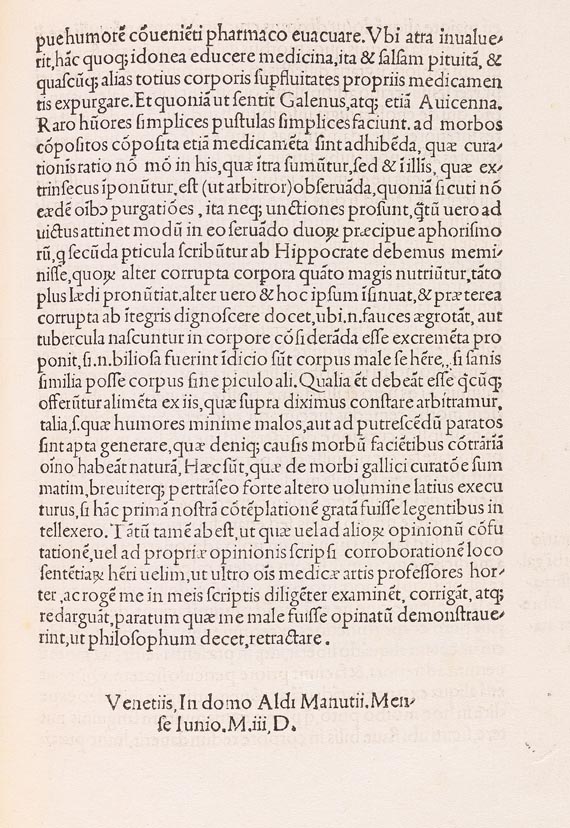Cover

21
Nicolaus Leonicenus
Libellus de epidemia (1497)
Estimate:
€ 24,000 / $ 27,840 Sold:
€ 25,200 / $ 29,231 (incl. surcharge)
Leonicenus, N., Libellus de Epidemia, quam vulgo morbum Gallicum vocant. Venice, Aldus Manutius, June 1497. Blue long-grained 19th century morocco binding by Charles Hering : (company label on front flying endpaper): Spine with gilt lettering and rich filigree gilt tooling betweenthe bands, boards with frames of 2 fillets and inside rhomb of a double fillet, center panel with later gilt-tooled monogram of John Rylands, iinside gilt borders and double gilt fillet border as well as marbled gilt edges. 4to. 29 unnumb. ll. Roman type, some Greek. 33 lines with printed marginalia, initial spaces with representatives.
Hain/Cop. 10019. - GW M17947. - Goff L 165. - BMC V 557. - BSB N-130. - Klebs 599.1. - Renouard 14, 12. - Aldinen-Slg. Berlin 31. - Stillwell 440. - Garrison/Morton 2363. - Norman Coll. 121. - First edition of the first scientific treatise on Syphilis , at the same time one of the few medical texts printed by Aldus. - Niccolò Leoniceno, important hellenist and professor for medicine in Ferrara, "was one of the most famous physicians of his days; he was one of the most renowned reformers of medicine in the 16th century" (Hirsch/Hüb.). Together with other Renaissance scholars, he released Aldus' great Aristoteles edition, translated Galen and Hippocrates and wrote several influential tractates, in which he criticized the Latin and Arabic translations of Greek physicians. He caused a stir with his proof of translation flaws in Plinius' natural history. In this tractate on Syphilis, which broke out under the soldiers of Karl VIII. in Naples in 1495 and spread all over Europe, Leoniceno was the first to described the disease's etiology with rational means. Accordingly, he managed to prove that the disease had already been in existence for a long time on the basis of descriptions by ancient authors. "One of the earliest treatises on the subject, and one of very few medical books printed by Aldus Manutius. Leoniceno includes a good description of syphilitic hemiplegia" (Garrison/Morton).
Splendid copy from the library of the famous collector Lord Spencer (pastedown with his gilt-tooled calf ex-libris), who had it bound by Charles Hering, London's leading book binder in those days, in this binding. Later it became part of the renowned collection of John Ryland (pastedown with engr. ex-libris, with collector's stamp on verso of title), and then it went to the hands of H. N. Friedlaender (auction at Christie's 23 April 2001). Title also with small monogram 'D' by an early hand, the initially rear flying endpaper with entries by a 15th century hand bound in (hinting at Galen, Dioscorides, Plinius the Elder and Plutarch).
Condition: Upper corners laminated in former times, beginning with 91 (-118), this copy obviously was part of a Sammelband. - Outer side gutter with small traces of damp, edges of binding here and there rubbed, front joint scraped in places. Very well-preserved and complete copy with errata sheet at the end. "A most desirable copy of this elegant, curious and rare volume" (Dibdin, Bibliotheca Spenceriana).
Hain/Cop. 10019. - GW M17947. - Goff L 165. - BMC V 557. - BSB N-130. - Klebs 599.1. - Renouard 14, 12. - Aldinen-Slg. Berlin 31. - Stillwell 440. - Garrison/Morton 2363. - Norman Coll. 121. - First edition of the first scientific treatise on Syphilis , at the same time one of the few medical texts printed by Aldus. - Niccolò Leoniceno, important hellenist and professor for medicine in Ferrara, "was one of the most famous physicians of his days; he was one of the most renowned reformers of medicine in the 16th century" (Hirsch/Hüb.). Together with other Renaissance scholars, he released Aldus' great Aristoteles edition, translated Galen and Hippocrates and wrote several influential tractates, in which he criticized the Latin and Arabic translations of Greek physicians. He caused a stir with his proof of translation flaws in Plinius' natural history. In this tractate on Syphilis, which broke out under the soldiers of Karl VIII. in Naples in 1495 and spread all over Europe, Leoniceno was the first to described the disease's etiology with rational means. Accordingly, he managed to prove that the disease had already been in existence for a long time on the basis of descriptions by ancient authors. "One of the earliest treatises on the subject, and one of very few medical books printed by Aldus Manutius. Leoniceno includes a good description of syphilitic hemiplegia" (Garrison/Morton).
Splendid copy from the library of the famous collector Lord Spencer (pastedown with his gilt-tooled calf ex-libris), who had it bound by Charles Hering, London's leading book binder in those days, in this binding. Later it became part of the renowned collection of John Ryland (pastedown with engr. ex-libris, with collector's stamp on verso of title), and then it went to the hands of H. N. Friedlaender (auction at Christie's 23 April 2001). Title also with small monogram 'D' by an early hand, the initially rear flying endpaper with entries by a 15th century hand bound in (hinting at Galen, Dioscorides, Plinius the Elder and Plutarch).
Condition: Upper corners laminated in former times, beginning with 91 (-118), this copy obviously was part of a Sammelband. - Outer side gutter with small traces of damp, edges of binding here and there rubbed, front joint scraped in places. Very well-preserved and complete copy with errata sheet at the end. "A most desirable copy of this elegant, curious and rare volume" (Dibdin, Bibliotheca Spenceriana).
21
Nicolaus Leonicenus
Libellus de epidemia (1497)
Estimate:
€ 24,000 / $ 27,840 Sold:
€ 25,200 / $ 29,231 (incl. surcharge)


 Lot 21
Lot 21 